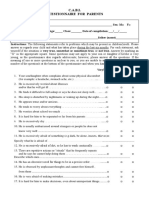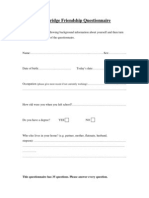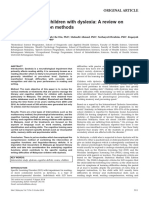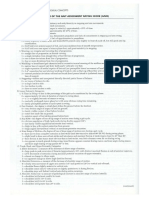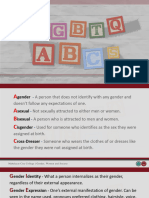DBD Rating Scale
DBD Rating Scale
Uploaded by
Faizz NawiCopyright:
Available Formats
DBD Rating Scale
DBD Rating Scale
Uploaded by
Faizz NawiCopyright
Available Formats
Share this document
Did you find this document useful?
Is this content inappropriate?
Copyright:
Available Formats
DBD Rating Scale
DBD Rating Scale
Uploaded by
Faizz NawiCopyright:
Available Formats
Parent / Teacher DBD Rating Scale
Child's Name: Form Completed by: Grade: Date of Birth: Sex: Date Completed: Check the column that best describes your/this child. Please write DK next to any items for which you don't know the answer.
Not at All 1. 2. 3. 4. 5. 6. 7. 8. 9. 10. 11. 12. 13. 14. 15. 16. 17. 18. 19. 20. 21. 22. 23. 24. 25. 26. 27. 28. 29. 30. 31. 32. 33. 34. 35. 36. 37. 38. 39. 40. 41. 42. 43. 44. 45. often interrupts or intrudes on others (e.g., butts into conversations or games) has run away from home overnight at least twice while living in parental or parental surrogate home (or once without returning for a lengthy period) often argues with adults often lies to obtain goods or favors or to avoid obligations (i.e., "cons" others) often initiates physical fights with other members of his or her household has been physically cruel to people often talks excessively has stolen items of nontrivial value without confronting a victim (e.g., shoplifting, but without breaking and entering; forgery) is often easily distracted by extraneous stimuli often engages in physically dangerous activities without considering possible consequences (not for the purpose of thrill-seeking), e.g., runs into street without looking often truant from school, beginning before age 13 years often fidgets with hands or feet or squirms in seat is often spiteful or vindictive often swears or uses obscene language often blames others for his or her mistakes or misbehavior has deliberately destroyed others' property (other than by fire setting) often actively defies or refuses to comply with adults' requests or rules often does not seem to listen when spoken to directly often blurts out answers before questions have been completed often initiates physical fights with others who do not live in his or her household (e.g., peers at school or in the neighborhood) often shifts from one uncompleted activity to another often has difficulty playing or engaging in leisure activities quietly often fails to give close attention to details or makes careless mistakes in schoolwork, work, or other activities is often angry and resentful often leaves seat in classroom or in other situations in which remaining seated is expected is often touchy or easily annoyed by others often does not follow through on instructions and fails to finish schoolwork, chores, or duties in the workplace (not due to oppositional behavior or failure to understand instructions) often loses temper often has difficulty sustaining attention in tasks or play activities often has difficulty awaiting turn has forced someone into sexual activity often bullies, threatens, or intimidates others is often "on the go" or often acts as if "driven by a motor" often loses things necessary for tasks or activities (e.g., toys, school assignments, pencils, books, or tools) often runs about or climbs excessively in situations in which it is inappropriate (in adolescents or adults, may be limited to subjective feelings of restlessness) has been physically cruel to animals often avoids, dislikes, or is reluctant to engage in tasks that require sustained mental effort (such as schoolwork or homework) often stays out at night despite parental prohibitions, beginning before age 13 years often deliberately annoys people has stolen while confronting a victim (e.g., mugging, purse snatching, extortion, armed robbery) has deliberately engaged in fire setting with the intention of causing serious damage often has difficulty organizing tasks and activities has broken into someone else's house, building, or car is often forgetful in daily activities has used a weapon that can cause serious physical harm to others (e.g., a bat, brick, broken bottle, knife, gun)
CTADD
Just a Little
Pretty Much
Very Much
parent/teacher dbd.v1
University at Buffalo Center for Children and Families 318 Diefendorf Hall 3435 Main Street Buffalo, NY 14214 716-829-2244
SCORING INSTRUCTIONS FOR THE DISRUPTIVE BEHAVIOR DISORDER RATING SCALE There are two ways to determine if a child meets the criteria for DSM IV diagnoses of Attention-Deficit/Hyperactivity Disorder, Oppositional Defiant Disorder, or Conduct Disorder. The first method involves counting symptoms for each disorder using the Disruptive Behavior Disorders (DBD) rating scale. The second method involves comparing the target child's factor scores on the DBD Rating Scale to established norms. The factor scores method is preferable for diagnosis of females (e.g., using a 2 SD cutoff), as the symptom counting method often results in underdiagnosis of female children. Please note that Items 10, 14, and 21 are from DSM-III-R and are not included in the scoring for a DSM-IV diagnosis. Method 1: Counting Symptoms To determine if a child meets the symptom criteria for DSM IV diagnoses of Attention-Deficit/Hyperactivity Disorder, Oppositional Defiant Disorder, or Conduct Disorder as measured by the DBD Parent / Teacher Rating Scale, count the number of symptoms that are endorsed "pretty much" or "very much" by either parent or teacher in each of the following categories: Note that impairment and other criteria must be evaluated in addition to symptom counts. Attention-Deficit/Hyperactivity Disorder Attention-Deficit/Hyperactivity Disorder - Inattention Symptoms (items 9, 18, 23, 27, 29, 34, 37, 42, 44) 6 or more items must be endorsed as "pretty much" or "very much" to meet criteria for Attention-Deficit/Hyperactivity Disorder, Predominantly Inattentive Type. The six items may be endorsed on the teacher DBD, the parent DBD, or can be a combination of items from both rating scales (e.g., 4 symptoms endorsed on the teacher DBD and 2 separate symptoms endorsed on the parent DBD). The same symptom should not be counted twice if it appears on both versions (parent and teacher) of the rating scale. Attention-Deficit/Hyperactivity Disorder - Hyperactivity/impulsivity Symptoms (items 1, 7, 12, 19, 22, 25, 30, 33, 35) 6 or more items must be endorsed as "pretty much" or "very much" on the parent and/or the teacher DBD to meet criteria for AttentionDeficit/Hyperactivity Disorder, Predominantly Hyperactive-Impulsive Type If 6 or more items are endorsed for Attention-Deficit/Hyperactivity Disorder - inattention and 6 or more items are endorsed for AttentionDeficit/Hyperactivity Disorder - hyperactivity/impulsivity, then criteria is met for Attention-Deficit/Hyperactivity Disorder, Combined Type Some impairment from the symptoms must be present in two or more settings (e.g., school, home) Oppositional Defiant Disorder Oppositional Defiant Disorder (items 3, 13, 15, 17, 24, 26, 28, 39) A total of 4 or more items must be endorsed as "pretty much" or "very much" on either the parent or the teacher DBD to meet criteria for Oppositional Defiant Disorder _______ Conduct Disorder Conduct Disorder - aggression to people and animals (items 6, 20, 31, 32, 36, 40, 45) Conduct Disorder - destruction of property (items 16, 41) Conduct Disorder - deceitfulness or theft (items 4, 8, 43) Conduct Disorder - serious violation of rules (items 2, 11, 38) A total of 3 or more items in any category or any combination of categories must be endorsed as "pretty much" or "very much" on either the parent or the teacher DBD to meet criteria for Conduct Disorder Method 2: Using Factor Scores Factor scores for the two ADHD and ODD dimensions for teacher ratings on the DBD are reported in Pelham, et al (1992), Teacher ratings of DSMIII-R symptoms for the disruptive behavior disorders: Journal of the American Academy of Child and Adolescent Psychiatry, 31, 210-218. The factor scores for DSM IV factors are the same as for the DSM III-R factors reported in that paper. To determine how a child's scores compare to normative data, compute the average rating for the items from each factor (listed below) using the following scoring: Not at all = 0, Just a little = 1, Pretty Much = 2, Very much = 3. Then, using the information from the attached table of norms, determine where the child falls in relation to other children. A variety of cutoff scores can be used (e.g., 2 standard deviations above the mean). Factors Oppositional / Defiant (items 3, 13, 15, 17, 24, 26, 28, 39) Inattention (items 9, 18, 23, 27, 29, 34, 37, 42, 44) Impulsivity / Overactivity (items 1, 7, 12, 19, 22, 25, 30, 33, 35)
CTADD
You might also like
- Child Behavior Checklist (CBCL) PDFDocument3 pagesChild Behavior Checklist (CBCL) PDFRocio Jimenez Carcamo50% (8)
- Staxi-2 ScaleDocument4 pagesStaxi-2 ScaleIshani MajumdarNo ratings yet
- Request For Withdrawal FormDocument1 pageRequest For Withdrawal Formapi-325876920No ratings yet
- Vanderbilt Assessment Scale-Parent Informant #6175Document3 pagesVanderbilt Assessment Scale-Parent Informant #6175Chris100% (5)
- Autism Behavior ChecklistDocument1 pageAutism Behavior Checklistkwing2xlovesme67% (3)
- Eyberg Child Behavior InventoryDocument15 pagesEyberg Child Behavior InventoryEspíritu Ciudadano33% (3)
- ABC Autism Behavior ChecklistDocument2 pagesABC Autism Behavior ChecklistAdriane Carqueijo67% (3)
- Eyberg-Child Behavior Inventory (Parents)Document4 pagesEyberg-Child Behavior Inventory (Parents)octavian100% (2)
- ESDM Acquisition and Bar Graph 03 SampleFilledDocument3 pagesESDM Acquisition and Bar Graph 03 SampleFilledGökçe Gökçümen KocaNo ratings yet
- Questions About Behavioral Function (Qabf)Document3 pagesQuestions About Behavioral Function (Qabf)Registro psiNo ratings yet
- Autism Diagnostic Observation Schedule - Second Edition (ADOS-2)Document5 pagesAutism Diagnostic Observation Schedule - Second Edition (ADOS-2)shizuka samaNo ratings yet
- ATEC-AUTISM Spectrum Disorder ChecklistDocument1 pageATEC-AUTISM Spectrum Disorder ChecklistAnonymous jH2v0B100% (1)
- Adhd Rating ScaleDocument2 pagesAdhd Rating Scaleapi-644318316100% (1)
- Vanderbilt ADHD Diagnostic Parent Scoring & InstructionsDocument3 pagesVanderbilt ADHD Diagnostic Parent Scoring & InstructionsPsiholog Alina Mirela CraiuNo ratings yet
- DST-S Sample ReportDocument8 pagesDST-S Sample ReportravibhargavaraamNo ratings yet
- BASC2 ReportDocument42 pagesBASC2 ReportEspíritu Ciudadano100% (2)
- SDQ ManualDocument27 pagesSDQ Manualgulitt100% (1)
- Jr. EPQDocument5 pagesJr. EPQShubham BanerjeeNo ratings yet
- Pivotal Response Treatment For Children With Autism in School SetDocument45 pagesPivotal Response Treatment For Children With Autism in School SetbrunaNo ratings yet
- GARS 2 - ArticleDocument20 pagesGARS 2 - ArticleGoropadNo ratings yet
- The Child Bipolar Questionnaire (CBQ) A Screening Instrument For Juvenile-Onset Bipolar DisorderDocument8 pagesThe Child Bipolar Questionnaire (CBQ) A Screening Instrument For Juvenile-Onset Bipolar DisorderSana KhanNo ratings yet
- DassDocument2 pagesDassAnastasia Gomes100% (1)
- Binge Eating Scale BES PDFDocument1 pageBinge Eating Scale BES PDFSînziana EnescuNo ratings yet
- AQ ChildDocument3 pagesAQ ChildClaudia González Miranda100% (1)
- The Childhood Autism Spectrum Test (CAST) : Yes No Yes No Yes No Yes No Yes NoDocument4 pagesThe Childhood Autism Spectrum Test (CAST) : Yes No Yes No Yes No Yes No Yes NoZainub A Khan100% (1)
- Cabi EnglishDocument3 pagesCabi EnglishCarlo CianchettiNo ratings yet
- MCHATDocument2 pagesMCHATPramita SariNo ratings yet
- Disruptive Behavioral DisorderDocument5 pagesDisruptive Behavioral Disorderapi-228136529100% (1)
- Introduction To Social Skills TrainingDocument9 pagesIntroduction To Social Skills TrainingNabiha100% (2)
- Depression Scale Children RCADS 2015Document2 pagesDepression Scale Children RCADS 2015BeeHoof100% (1)
- Psydclpsy PDFDocument55 pagesPsydclpsy PDFReeshabhdev GauttamNo ratings yet
- FQ - Friendship QuestionnaireDocument8 pagesFQ - Friendship QuestionnaireAlex-stim LeonNo ratings yet
- Quesioner ABCDocument2 pagesQuesioner ABCJaya AriaNo ratings yet
- Beck's Depression Inventory - 0Document3 pagesBeck's Depression Inventory - 0Dr Fairuz Nazri Abd RahmanNo ratings yet
- Pep RDocument12 pagesPep Rnays meetNo ratings yet
- Interventions For Children With Dyslexia A Review On Current Intervention MethodsDocument10 pagesInterventions For Children With Dyslexia A Review On Current Intervention Methodseebook123456No ratings yet
- CBCL ParentsDocument4 pagesCBCL ParentsMerijn MattheijssenNo ratings yet
- OP-2 Behavior Intervention PlanDocument4 pagesOP-2 Behavior Intervention Planapi-284512141100% (1)
- Test 6 How Impulsive Are YouDocument7 pagesTest 6 How Impulsive Are YouJunaid AhmadNo ratings yet
- MOST COMMON PSYCHOLOGICAL TEST-army-carabineros-armadaDocument4 pagesMOST COMMON PSYCHOLOGICAL TEST-army-carabineros-armadaScribdTranslationsNo ratings yet
- ABC Autism Behavior ChecklistDocument2 pagesABC Autism Behavior ChecklistSanthoshi TallaNo ratings yet
- TSCC SheettDocument2 pagesTSCC Sheettadriana martorell0% (1)
- STROOP InstructionsDocument8 pagesSTROOP InstructionsScribdTranslations100% (2)
- Scared YouthDocument2 pagesScared Youthnarcis2009100% (1)
- Nimhans SLD ReportDocument19 pagesNimhans SLD Reportdreww.breww12No ratings yet
- SNAP-IV Parent Teacher ENGLISHDocument2 pagesSNAP-IV Parent Teacher ENGLISHGarima Arora100% (1)
- PSWQ CDocument1 pagePSWQ Celutaf100% (1)
- GarsDocument2 pagesGarsAnonymous uWlv9rllaNo ratings yet
- UytDocument14 pagesUytdoina cricimaruNo ratings yet
- Eat 26 Rating Scale 7.2Document2 pagesEat 26 Rating Scale 7.2Cristina Zvezdenco100% (1)
- List of Psychological TestsDocument15 pagesList of Psychological TestsPatricia AnneNo ratings yet
- Vanderbilt Scale Parent and TeacherDocument6 pagesVanderbilt Scale Parent and Teacherblessy jonesNo ratings yet
- Case - NimhansDocument5 pagesCase - NimhansRajashree Praveen100% (1)
- Childhood Behavior Checklist (CBCL) : The Child Behavior Checklist For Ages 6-18 IsDocument2 pagesChildhood Behavior Checklist (CBCL) : The Child Behavior Checklist For Ages 6-18 IsNazema_Sagi50% (2)
- Behavioral Intervention PlanDocument14 pagesBehavioral Intervention Planapi-255571079No ratings yet
- Childhood Autism Rating Scale, 2nd EditionDocument25 pagesChildhood Autism Rating Scale, 2nd Editionarunimajha127No ratings yet
- Scared ParentDocument2 pagesScared ParentWDIV/ClickOnDetroitNo ratings yet
- Conners Rating Scale For Parents Revised L ExampleDocument3 pagesConners Rating Scale For Parents Revised L Examplesirinyamd50% (2)
- DBD legenda da escala - em inglêsDocument3 pagesDBD legenda da escala - em inglêsDiego OliveiraNo ratings yet
- DBD Rating ScaleDocument3 pagesDBD Rating ScaleDevashish PatelNo ratings yet
- Teacher Vanderbilt v2Document3 pagesTeacher Vanderbilt v2nb437459No ratings yet
- Program Bina BakatDocument2 pagesProgram Bina BakatFaizz NawiNo ratings yet
- Sri Bunga RestaurantDocument23 pagesSri Bunga RestaurantFaizz NawiNo ratings yet
- Level: Ref. Number: Apel: (Office Use Only)Document13 pagesLevel: Ref. Number: Apel: (Office Use Only)Faizz NawiNo ratings yet
- Cabin Crew Application FormDocument1 pageCabin Crew Application FormFaizz NawiNo ratings yet
- Reply Slip For Seminar AttendanceDocument1 pageReply Slip For Seminar AttendanceFaizz NawiNo ratings yet
- English SbaDocument12 pagesEnglish SbaPPSSPP DBZ GAMEZNo ratings yet
- Lesson 1. Women and Education: 1. What Will You Learn From This Module?Document14 pagesLesson 1. Women and Education: 1. What Will You Learn From This Module?Jose Cruz JrNo ratings yet
- Position Paper - Republic of IndiaDocument3 pagesPosition Paper - Republic of Indianhhvp5sq8mNo ratings yet
- Society For Protection of Women & Children - Hyderabad City Police, Telangana Bharosa' - Support Center For Women & ChildrenDocument4 pagesSociety For Protection of Women & Children - Hyderabad City Police, Telangana Bharosa' - Support Center For Women & ChildrenSrinivas GadadasNo ratings yet
- Assignment 4 - Workplace Harassment Final DraftDocument4 pagesAssignment 4 - Workplace Harassment Final DraftAraceli Gloria-Francisco100% (1)
- Smoking, Smoking CessationDocument5 pagesSmoking, Smoking CessationNikhilNo ratings yet
- "Your Opinion Doesn't Matter, Anyway": Exposing Technology-Facilitated Gender-Based Violence in An Era of Generative AIDocument39 pages"Your Opinion Doesn't Matter, Anyway": Exposing Technology-Facilitated Gender-Based Violence in An Era of Generative AIFelipe MoraesNo ratings yet
- An Analysis of African-American Criticism in Kate Chopin's Desiree's BabyDocument3 pagesAn Analysis of African-American Criticism in Kate Chopin's Desiree's BabyMelindaNo ratings yet
- Syria Human RightsDocument6 pagesSyria Human RightsUK Mission to the UNNo ratings yet
- Law IADocument15 pagesLaw IANaje CampbellNo ratings yet
- MillenialsDocument4 pagesMillenialshahatdog1015No ratings yet
- Human Rights TextbookDocument733 pagesHuman Rights TextbookVrushika Doshi100% (1)
- Corporal PunishmentDocument15 pagesCorporal PunishmentBea Marie EcleviaNo ratings yet
- NCERT - Grade 10 - Gender, Religion and Caste - Lesson Plan 2 - 6th June 2019Document15 pagesNCERT - Grade 10 - Gender, Religion and Caste - Lesson Plan 2 - 6th June 2019gyana SamuelNo ratings yet
- Current Scenarion of Caste in IndiaDocument18 pagesCurrent Scenarion of Caste in IndiaAvinashNo ratings yet
- NHD Process PaperDocument2 pagesNHD Process Paperapi-498878015No ratings yet
- Social StratificationDocument17 pagesSocial StratificationAlisha ShabbirNo ratings yet
- English Test IV° Medio Guía de Sintesis Junio: Colegio María Griselda ValleDocument3 pagesEnglish Test IV° Medio Guía de Sintesis Junio: Colegio María Griselda ValleYorka OlavarriaNo ratings yet
- Understanding LGBTQDocument24 pagesUnderstanding LGBTQyin yinNo ratings yet
- Resolution No. 12-2024 (REDAS)Document2 pagesResolution No. 12-2024 (REDAS)shieladomingo94No ratings yet
- Promoting Internal Peace and SecurityDocument5 pagesPromoting Internal Peace and SecurityPaulo Antonio Buenavides ChingNo ratings yet
- Social Media AdddictionDocument14 pagesSocial Media AdddictionOsayomoreNo ratings yet
- Signals That Indicate CoherenceDocument10 pagesSignals That Indicate CoherenceAlpha Joy ProvidoNo ratings yet
- CBSE Class 12 English The Enemy Project FileDocument14 pagesCBSE Class 12 English The Enemy Project Fileironhero109No ratings yet
- Human Right First SubjectDocument8 pagesHuman Right First SubjectMikel ScoutNo ratings yet
- Definition of RobberyDocument5 pagesDefinition of RobberyJetlee EstacionNo ratings yet
- CSS Syllabus: Subject: Gender StudiesDocument4 pagesCSS Syllabus: Subject: Gender StudiesAbdul Hafeez100% (1)
- Protection of Women Under IHLDocument5 pagesProtection of Women Under IHLvarunendra pandeyNo ratings yet
- Literature Review On Juvenile DelinquencyDocument5 pagesLiterature Review On Juvenile Delinquencyafdtveepo100% (1)

























